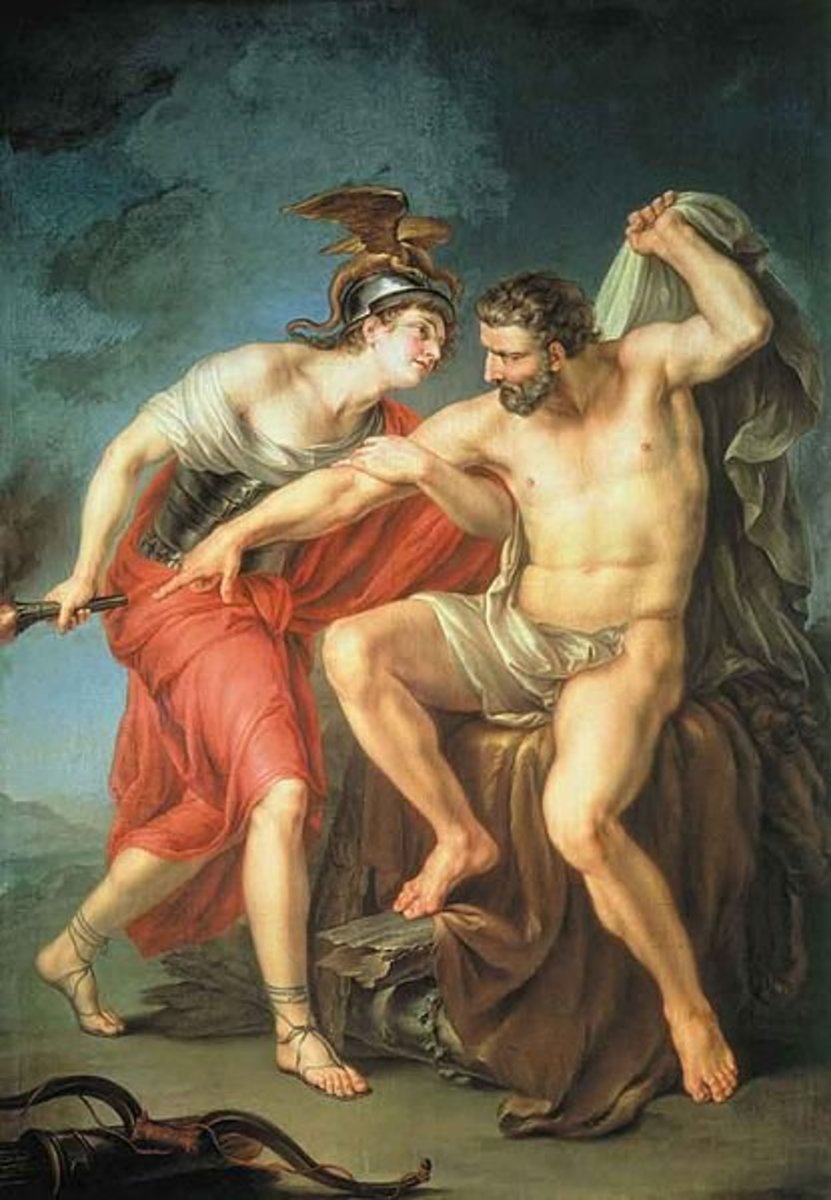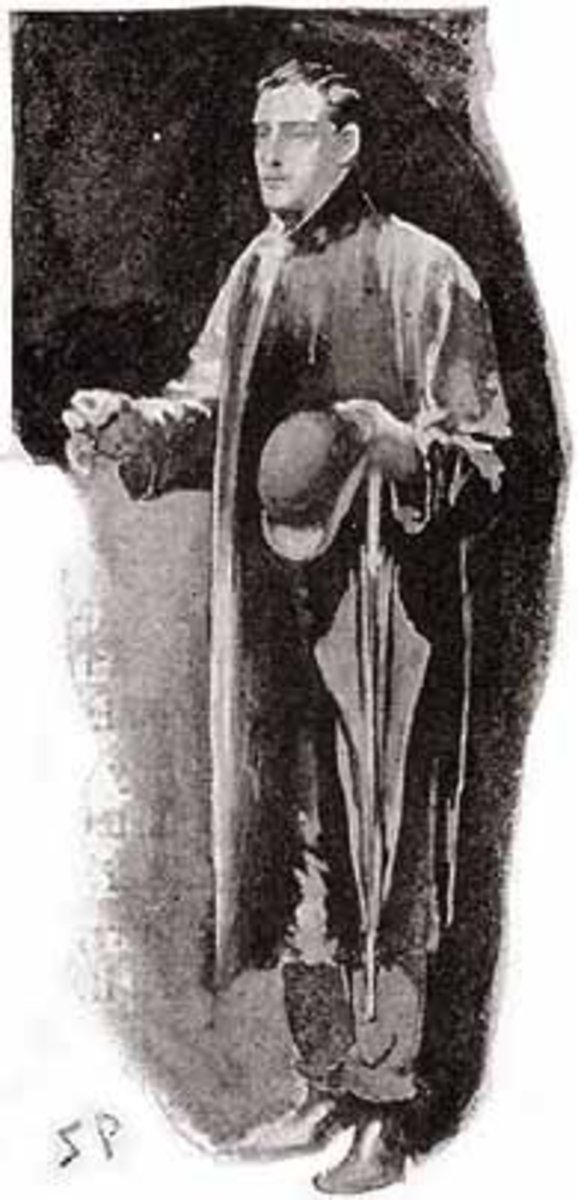Killing the Mary-Sue
Murder Your Darlings
WARNING! WARNING! SPOILER-HEAVY!!!
When most people hear “kill Mary-Sue” I’m sure they rejoice. They’d like nothing better than to see all Mary-Sues dead and gone from the fan fiction earth.
Well, if that’s what those morons are looking for, they’re going to have to look someplace else. Nope, this week is all about why people feel compelled to kill off their fan character—and why we can blame a lot of it on the media and mythology.
(I’m not passing the buck here, it really is their fault.)
![By Creator:John Garrick (John Garrick, 1862) [Public domain], via Wikimedia Commons By Creator:John Garrick (John Garrick, 1862) [Public domain], via Wikimedia Commons](https://usercontent1.hubstatic.com/7198788_f520.jpg)
PART 1: WHAT’S A MARY-SUE DEATH?
In fan fiction, one surefire sign of Mary-Sueism is when the fan-created character dies in the story, and is then grieved over by all the canon characters who profess their love and admiration for her or him. This is a long standing trend, and while there seems to be less of this bizarre offing of your own character in fanfics as of late, it’s still out there—the Mary-Sues are dropping like flies!
But that seems stupid. Why would you kill off your own character? You’ve worked so hard on her or him, and you had a good story going … why kill them off at all?
The Mary-Sue death isn’t so simply explained (shaddap with the groaning!). It’s not simply just, “Eh, I’ll just kill her here. That sounds cool.” No, no, as it turns out, reasons for killing off your beloved character are actually quite varied—and more often than not, heavily influenced by outside entertainment forces.
First, let’s look at the reasons why people feel compelled to give their characters the big dirt nap:
· THAT’S WHAT’S SUPPOSED TO HAPPEN: People kill their character because they think that’s what’s supposed to happen in a good story, and they think that way because they’ve seen it so much in media. There are thousands of movies, TV shows, comic books, novels, cartoons etc. where a character dies, and people are misled into thinking that’s the only way a story can be told. This relates to Part 2, so I’ll leave it alone for now.
· WELL, EVERYBODY ELSE IS DOING IT: Aha, see?! As with erotic fanfic writing, some people feel that they should kill off their character just because everybody else seems to be doing theirs in. Doesn’t go much further than that … which is really lame. Don’t be a lemming!! Just because you see other authors eliminating their characters doesn’t mean you should feel compelled to do so as well! That’s a really dumb reason!
· SUICIDE BY CHARACTER: This is a disturbing one—frequently, the character is a self-insert (more often a veiled insert, not usually an obvious one) of the author, and then they die at the end of the story. Occasionally the author writes that they die in the story to either a) see how people will react and gauge their popularity based on the responses, which is sick, or b) they’re actually feeling suicidal, and they’re experimenting through their self-insert character. I find both very alarming (are you that insecure about your self-worth that you need to metaphorically commit suicide in order to get a baseline reading on how much people like you?), but the real suicidal feelings one really gets me worried. If you ever feel so bad that you find yourself writing stories where you or your alter ego dies because that’s something you’ve actually considered/fantasized about, please find help. This isn’t healthy, and it’s the first step towards something really horrible.
· COPING WITH A DEATH: It seems odd, but for some people who have experienced the loss of a loved one, they sometimes channel that pain into their writing. People have different methods of coping with death, and writing is often a potent way of expressing shock, grief, anger and horror when no other means are available. It may sound strange, but some people kill off their characters because they can’t find a way to express their feelings to the rest of the world otherwise. They’re not punishing their character; they’re saying, “This is what it feels like for me.”
· TIME FOR AN UPGRADE: Occasionally, people get sick of their characters, so they kill them as an excuse for a do-over or to create an entirely new character. That’s kind of lame; your character is your creation, and you should never get sick of your character. If you’re sick of your character, then most likely you’re riddled with writer’s block and you’re only getting frustrated. (I’ll admit to removing characters that didn’t work out, but I never went as far as to kill one of them.)
· DEATH AS PUNISHMENT: This is another scary one. There are times when an author’s life is going so badly and they’re so filled with anger—especially at themselves, even if it’s unwarranted—but they have no constructive outlet for it. Instead, they take out their wrath on one of their characters and kill them. While it’s better to take out your aggression on a non-entity such as a fanfic character and not somebody, y’know, real, if you find yourself repeatedly torturing and/or killing characters because you’re in such turmoil, you really should go and find help—before writing isn’t enough and you start acting out for real.
· HEROIC DEATH: This is explained more in Part 2 here, but there are writers who kill off a character just to demonstrate how heroic they are—because, as we’ve seen, heroes in fiction, and mythology are often shown enduring one last, mighty battle in which they’ll perish, only to be worshipped by others for their fearlessness and courageousness. We often worship real life heroes (metaphoric worship—work with me here) in similar ways, throwing parades in their honor, turning their birthdays into holidays, rewarding them and turning their life stories into movies and so forth. Some writers think that the only way to really show how brave their character is and to have people truly appreciate them is to kill ‘em dead and then show everybody mourning over them. Whatever.
· UNDER PRESSURE: I’ve seen this a few times; somebody writes a fic with a character who is either clearly a Mary-Sue or has been accused of Sueism, and the bad reviews steadily mount up. The author first denies any Sueism, and then suddenly kills off the character. Why? To escape the harassment! Once the character is dead, the negative remarks quickly die down. The death was probably never planned originally, but the author killed the character just to stop the bullying. This really pisses me off, and to me it smacks too much of those more kids who really do kill themselves because of relentless bullying. How horrible is that? The author feels like the only way to escape the torment is to kill the character they love? That’s not fair … and yet, it happens.
· I DIDN’T KNOW HOW TO END THE STORY: Sometimes writers feel like they have no way to end the story, and once they kill their character, they no longer feel any need to continue writing. Bull, says I. You are in control of your story, not your character. There are ways to end a story, and if you still feel the need to write, well, that’s what sequels are for. Don’t ice your character just because you don’t know what to write for an ending!
PART 2: DEATH IN MYTHOLOGY AND CAMPBELL’S HERO JOURNEY
Back in Week 7 I wrote about how various myths, legends and fairy tales have influenced every form of character in every form of entertainment since humans learned to communicate. Back then I was only talking about how those mythological characters have Mary-Sue and Gary-Stu-like qualities and how they’ve shaped characters like Harry Potter, Indiana Jones, Buffy, Luke Skywalker, and many, many, maaaaaaany others … what I left out at the time was that the ways they’ve died have also greatly influenced the way we write now as well.
Ever hear of Joseph Campbell? Campbell was a renowned mythologist, and over decades of studying mythology he found a set of patterns in every culture’s storytelling concerning the lives of their heroes. He termed it the hero’s journey (sometimes called the hero cycle, or monomyth). While the cycle itself is rather large, we’re only going to focus on two factors right now:
· THE FALL: the hero has been riding high for a while when he or she suddenly encounters a foe that they cannot defeat or can just barely defeat. The hero may be defeated, and while sometimes the hero survives the encounter but falls into disgrace, more frequently they die as a result of the battle.
· TRANSFORMATION: if the character dies, they either ascend into heaven to live as a god, are rewarded with otherworldly paradise, are punished severely for their hubris (pride), or are resurrected and sent to work again
Take a look at the following myths, and see if you can see the pattern that Campbell was talking about—then see if you can find it in any of books, shows, movies etc. you like. I’ll bet you’ll be shocked. Flabbergasted, even.
GREECE:
Greek mythology is famous for killing off their heroes, and they appear to be rather picky about who gets rewarded after death and who gets the shaft. Hercules, for example, was poisoned by his well meaning wife who thought that she was giving him a love charm (in the hero’s journey this would be the fall.) As his skin melted off of his body, Hercules could no longer endure the pain and built a massive funerary pyre, throwing himself atop the flames. As he slowly began to burn to death, Zeus sent either Athena or Nike (the goddess of victory—remember that) to rescue Hercules and bring him to Olympus. There, Hercules was healed and granted total godhood (in the hero’s journey, this would be transformation and ascension into heaven.)
Now, Bellerophon, on the other hand, wasn’t so lucky. Famous and wealthy after killing the Chimera, Bellerophon decided that he was entitled to visit his father Zeus at the tope of Mount Olympus. Saddling Pegasus, Bellerophon flew to Olympus’s peak—much to the outrage of Zeus, since it had been decreed that no mortal should ever visit the home of the gods. Zeus released a monstrous gadfly and sent it down to sting Pegasus. In agony, the winged horse screamed and reared, throwing Bellerophon out of the saddle (the fall—literally. And painfully.) The once mighty warrior slammed to earth, crashing into a thicket of brambles which scratched out his eyes. Alone and blind, the would-be king wandered as a beggar for years until he finally died, a pathetic joke of what he used to be, punished for his arrogance. (This would be transformation from hero to peasant and then a descent into hell. Get it?)
![Guido Reni [Public domain], via Wikimedia Commons Guido Reni [Public domain], via Wikimedia Commons](https://usercontent1.hubstatic.com/7198796.jpg)
VIKINGS:
Vikings were big on heroic death. When snow piled up eight feet past the door, making it impossible to go pillaging, they sat around and told stories about courageous Viking heroes, how the best way to die was in battle, where their souls would be guided to the Viking afterlife in Valhalla by the Valkyries, the divine shield-maidens. In Valhalla, they would be greeted by Odin and would be welcomed to an eternal feast while they waited for Ragnarok, the apocalyptic war between the gods and the Giants, where the souls of the fallen would fight on behalf of Odin.
That didn’t work out for all warriors, though. In the tale The Volsunga Saga, Brynhildr (more famously known as Brunhilde), was rescued from a ring of flame by the hero Sigurd (also more famously known as Siegfried). They fell in love, but a sorceress wanted Sigurd to marry her own daughter Gudrun, and gave Sigurd a potion that caused him to forget his love for Brynhildr. After disguising himself as his brother-in-law Gunnar, Sigurd again rescued Brynhildr from the ring of flame (though why she was still in there I never found out), and a broken-hearted Brynhildr married the real Gunnar instead (as she had vowed to marry a man who showed no fear.)
The secret came to light when, during an argument over who’s husband was mightier, Gudrun let it slip that it wasn’t Gunnar who rescued Brynhildr—it was actually Sigurd. Enraged at being lied to, used, thrown aside and manipulated into marrying a man she didn’t love, Brynhildr arranged for the murder of Sigurd, and then she herself killed his son. At Sigurd’s funeral, Brynhildr willed herself to cease living, and was burned with him on the funeral pyre. Together they went to Hel … which is quite the opposite of Valhalla.
![By Charles Butler (died 1918) [Public domain], via Wikimedia Commons By Charles Butler (died 1918) [Public domain], via Wikimedia Commons](https://usercontent2.hubstatic.com/7198803_f520.jpg)
ARTHURIAN LEGEND:
In Arthurian legend, King Arthur declared that a quest must be made for the Holy Grail after a vision of a golden angel holding the sacred cup appeared before all of the knights of the Round Table. It was a foolish quest, ending in utter failure and the deaths of many brave knights—particularly the death of Sir Galahad.
Galahad was the son of Sir Lancelot. He was just as skilled a fighter as his father, and all agreed that, of all the knights put together, Galahad was the most pious and saintly. If anyone was going to find the Grail, it would be Galahad.
Setting out on the treacherous search with Sir Bors and Sir Percival, Galahad heads straight to the court of his grandfather, King Pelles, also known as the Grail King. King Pelles has known that Galahad was fated to take the Grail, and he brought the knight to the sacred chamber, instructing him to take the chalice to the holy city of Sarras. Galahad did as he was told, but he never made it to the city; to Bors and Percival’s shock, Galahad, still holding the Grail, ascended bodily into heaven, never to be seen again.
![Joseph Noel Paton [Public domain], via Wikimedia Commons Joseph Noel Paton [Public domain], via Wikimedia Commons](https://usercontent1.hubstatic.com/8647800.jpg)
ANCIENT CENTRAL MEXICO:
The ancient Aztec and Mayan civilizations are pretty much the most death-obsessed cultures that I’ve come across. When they weren’t sacrificing humans as horrifically as possible (Apocalypto doesn’t even come close), or creating the freakiest statues and artwork the planet as ever seen, they were creating highly detailed mythologies … in which people die, of course.
In Aztec mythology, the divine hero twins Hunahpu and Xbalanque irritated the hell out of the lords of hell with their loud ball playing. The king of the underworld Xibalba invited the twins to play a ball game, but the guys were already wise to the corpse-god’s tricks; that’s how the king was able to lure their father and uncle to the underworld to kill them. Still, they thought it would be fun to screw with a bunch of ornery death gods and went to Xibalba, cleverly evading their tricks. Fate caught up with them when they were locked in the House of Bats and were forced to hide from the swarming demons. At length, Hunahpu cautiously peered out to see if the sun had risen yet, and a waiting bat monster cut off his head and flew away with it.
Horrified to see his brother dead, Xbalanque quickly placed a squash on Hunaphu’s neck (‘cuz that totally makes sense … not really) and brought him back to life. Together they returned to the playing fields to find the king of Xibalba and his team waiting there for them with Hunaphu’s head—which they wanted to use instead of a ball! The twins agreed to the challenge and, in the middle of the game, managed to swipe back the head and replaced it with the squash. Soon after, the twins decided to leap over a flaming oven (don’t ask me why, just go with it) and were burnt to death. The delighted lords of Xibalba scattered the ashes into a nearby river, but the ashes turned into catfish, and the catfish soon turned back into Hunaphu and Xbalanque.
The boys returned to Xibalba, suddenly armed with extraordinary magical powers, one of which was cutting one of them up and then bringing them back to life. The king of Xibalba was so amazed by the powers of these two youths (whom he didn’t recognize, even though they were perfectly human and everybody in Xibalba looked like an extra from The Walking Dead) that he begged them to cut him up and bring him back to life. The boys agreed to cut the king up … but they reneged on the resurrection part. With the king of the Xibalba gone, the boys installed their father as the new lord of the dead, and then together they ascended into the sky, where one became the moon and the other became the sun.
![Tepantitla mural of a ball player. Could also be known as, “HEADS UP!!!” By Daniel Lobo (Daquella manera) (Flickr) [CC-BY-2.0 (http://creativecommons.org/licenses/by/2.0)], via Wikimedia Commons Tepantitla mural of a ball player. Could also be known as, “HEADS UP!!!” By Daniel Lobo (Daquella manera) (Flickr) [CC-BY-2.0 (http://creativecommons.org/licenses/by/2.0)], via Wikimedia Commons](https://usercontent2.hubstatic.com/7198857_f520.jpg)
PART 3: DEATH IN THE MEDIA
(Remember what I said about this being spoiler-heavy!!! YOU’VE BEEN WARNED!!!)
Admit it, you’ve been influenced by something, whether it’s something from your life or from something like your favorite book or TV show, and it’s weaseled it’s way into your fiction.
Now, if you’re at all like me, then you’re into a lot of stuff. TV, books, movies, video games, comic books, anime, and all the genres that run amok therein. So, it should go without saying that in your travels in the paper and celluloid world that you have encountered a great many characters dying, right? You’ve probably encountered character death since you were a little kid, and those powerful stories (stories influenced by mythology!) really stick with you.
Don’t believe me? Keep reading …
Comic books alone have featured the deaths of what were supposed to be unstoppable heroes. Yes, even heavies like Superman and Wonder Woman have bit the dust; Superman was beaten to death by Doomsday, and Wonder Woman succumbed to her injuries brought about while fighting Neron, the Prince of Hell.
Captain America was gunned down, Wolverine died after Magneto ripped the adamantium off his bones (only took him twenty-some odd years to realize that adamantium was METAL, apparently), and Batman died after being blasted by Darkseid’s omega powers (… or that’s what it looked like.) Robins 2 and 4 have died. Ultimate Spider-man keeled over. Supergirl died. And Phoenix … well, everybody’s lost count of how many times she’s bought the farm. The original Batwoman, Rorschach, Green Lantern, Flash, Colossus, Elektra, Black Canary, Nightcrawler (AAAAAGGGGGHHH!!!), Spider-woman, Big Barda, Donna Troy, Green Arrow, Martian Manhunter, and Psylocke are just a few of the superheroes who have died, and they’ve all died in heroic or tragic ways.
But it’s not just the heroes either. In comic books (as well as TV, books, etc.) their friends and family often get taken out too. The big difference is that once a loved one dies, they usually don’t come back.
In Spider-man, the original Gwen Stacey was kidnapped by the Green Goblin, and was accidentally killed by Spider-man when he tried to save her. Harry Osbourne (the second Green Goblin) was destroyed by drugs and alcohol, and Spidey’s Uncle Ben was killed by a criminal who broke into their home. Batman’s parents were murdered in front of him, and the Joker killed the second Robin. Superman’s parents, along with the entire race of Kryptonians (save for Supergirl) was completely wiped out. The deaths of these characters serve as motivation for the heroes and makes them evolve as characters (see Part 4.)
But just so you don’t get the wrong impression, it’s not just comics. Many characters have been killed off in books (Aslan, Gandalf, John Rambo, Armand the vampire, Harry Dresden, basically every magical adult in Harry Potter), movies (Spock, Old Yeller, Sparrow from The Forbidden Kingdom, Will Turner from Pirates of the Caribbean, Neo from The Matrix—Xibalba, HELLO?!), cartoons (the Magus in Gargoyles, Princess Yue from AtLAB), TV (Mulder, Buffy, Xena, Col. Henry Blake, anybody who dates Aiden from Syfy’s Being Human) and video games (Aerith from Final Fantasy7, Gray Fox Metal Gear Solid. )
All of these characters were heroic and well loved or respected, and their deaths were made courageously. Afterwards, they were all greatly mourned by everyone.
Gee, that sounds familiar …
So as you see, the Mary-Sue death exists in the media, and it’s damn near inescapable. It’s in every type of story out there, so it’s no wonder that people have been led to believe that it’s perfectly logical step to take when writing a story. Doesn’t make it right, necessarily, but that’s where everyone—that’s including you and me—comes from.
So for the haters out there … GET OVER IT.
PART 4: IS DEATH NECESSARY?
Don’t get the wrong idea; death in fiction isn’t such a bad idea that you feel like you should avoid it altogether. While I don’t want you to fall into a trend or use any of the dumb reasons I listed in Part 1, I do want you to be aware that sometimes death is necessary.
You look a little bit blank. That’s okay. In writing fiction, be it fanfic or original, your characters must, must evolve. They have to grow up, mature, and become better, more complex people, and sometimes the death of character forces them to do that.
In fiction, the death of a character forces the hero(es) to:
· EVOLVE: the death of a character is a wake-up call for the other hero(es). They experience jars them so badly that they look at their life and say, “I don’t want to be like this anymore. I want to be a better person.” They take steps to eliminate the negativity from their lives and start behaving in a more positive manner. They may become mature (stop acting like a loser and more like a responsible adult), give up a vice (drinking, smoking, etc.), help others (volunteer at charities) or take steps to end a feud (like ending a longstanding argument with a relative).
· CONFRONT A FEAR: Death has a way of helping people confront their fears because it reminds them of their own mortality. After a death many people realize how short their life is, and that they have to stop worrying and living in fear—otherwise, they would have wasted all their time. By “fear” I don’t mean something like arachnophobia—I mean fear of failure, fear of confrontation, fear of experimentation, fears that keep you too safe and keep you from fully living your life the way it was meant to be lived. An immortal character has to get over the fear of losing someone and accept that death is inevitable for normal, mortal people.
· CONFRONT INNER DARKNESS: The death of a character causes one or more of the other heroes to take a look at their own psyches. The trauma of experiencing a death can cause severe emotions to come boiling to the surface, and for some people, those emotions are dark and violent and they’ve been buried for a while. The hero feels such anger that they want to act out destructively, or they feel such despair that they want to commit suicide to escape the pain. The pain gets worse before it gets better, but after they’ve confronted that darkness and conquered it, they can begin to heal and become stronger.
· CONFRONT DOUBT: Often when a character dies the other surviving characters begin to have second thoughts about what they’re doing because their confidence is so shaken by what has happened. They doubt their strengths and worthiness, and question their role and their motives for what they’re doing. They might find that they haven’t been honest with themselves, or realize that their motives aren’t as benevolent as they had originally thought. They might lose all confidence in themselves, later reaching an epiphany which causes them to regain that strength and become the hero they once were.
· CONFRONT THE VILLAIN: In fiction, some heroes hedge against the thought of finally taking on the main villain either because they’re convinced that there’s a way to defeat them without direct violence, they’re not convinced that the villain is really that dangerous, or they’re waiting for the opportune time to strike. Finally, the heroes wait too long and the villain strikes, killing one of their own. This finally lights a fire under their butts and they fight back, taking down the villain. However, even when the villain is defeated the heroes grieve that they had waited too long to fight and vow never to wait so long again.
· LEARN HUMILITY: Sometimes a hero becomes too much of something: too strong, too powerful, too arrogant, too distant, too oblivious, too confident. When someone they care about dies—especially if this character has sacrificed themselves for the hero, died in a way that could have been prevented by the hero or was accidentally killed by the hero—the hero snaps out of it. S/he is wracked with guilt, and when they look back on themselves, they begin to see their faults and realize that they aren’t gods, they aren’t celebrities, but they’ve acted that way, and now people—people they love—are paying for it. There is no way to make up for the mistakes now, so the hero learns humility and strives to be a better person.
· UNITE: In many cases the death of one character causes all of the surviving characters to unite and form a stronger coalition in order to defeat the bad guy. Prior to the death, the heroes have squabbled amongst themselves and refused to cooperate, but after the death of a character that they are all friends with, they realize that they can’t continue to bicker and they must join together in order to take down the villain.
In addition, the death of a character shows us exactly how evil a villain can be, what lengths they’re willing to go to. In my rewrites of Lamia’s Revenge, Lamia Carna regularly picks off characters, and often in the most violent way as possible. She’s evil, but just saying that doesn’t mean a whole lot; I have to show you exactly how heartless and vile she could be by letting her kill a lot of important people.
Which leads me to my next point: not only does the death of a character serve as a catalyst for the growth of other characters or to illustrate the wickedness of a villain, it also forces your reader to feel emotion. Fear, shock, rage, disbelief—you should have developed your character so well that when you finally snuff them out, it should actually mean something to the reader. They should have a visceral reaction (even if they knew it was coming) to what happened, and that’ll make them turn the page.
Now, while I’ve done my fair-share of character murder in my original stuff, in my fan fiction I’ve only killed three characters … and if any of you know me or read my stuff, you know that I’ve written a LOT of fanfic (with more hopefully on the way … gotta get that writing practice in somehow). I’ve mentioned Vanessa several times already, but there’s also Miyuki, from my second (and thus far unwritten and who knows if I’ll ever get to it) Samurai Jack fanfic, and the temporarily named Qadira, from an unwritten (and don’t hold your breath waiting) Avatar: The Last Airbender fic.
Several blogs ago, I had written that I wasn’t totally sure why I had decided to call it curtains for Vanessa and then brought her back anyway, but luckily, since I refuse to throw anything story-related away, I actually recently came upon some notes I had made when I wrote the original version. I was surprised to see that aside from Vanessa being partially inspired by the character Hawkeye Pierce from TV’s MASH (TOTALLY forgot about that), I was actually drawing upon Campbell’s hero’s journey throughout much of the fic. In my notes I had written that my idea of having her die and come back to life actually fit into the ancient hero motif—I was unconsciously channeling mythological tradition into my fanfic!
Miyuki, on the other hand, is a different situation altogether. When I was outlining Nine Tails and its God-only-know-when-I’ll-get around-to-it sequel, it occurred to me that Samurai Jack would never give up his goal of returning to the past and defeating the demon Aku, but he could be easily side-tracked and could forget that as dopey as Aku could be, Aku was still a serious threat. In the sequel after Jack rushes back to town to help Miyuki repel a vindictive Aku’s ultra-robots, Jack and Miyuki spend so much time together that Jack stops worrying about Aku. Aku uses Jack’s newfound calm to his advantage and kills Miyuki before Jack has a chance to react. Jack is devastated, but vows vengeance and redoubles his efforts to find a portal home.
In the AtLAB fic, Qadira was a member of a demon race that was often erroneously referred to as Shadow Benders, due to their ability to blend, manipulate and travel through shadows. In the story, a teenaged Aang ‘n’ company accidentally stumbled into Shadow Bender territory and were captured by the irate demons. The demon lords decided to let them go, and ordered Qadira to escort them all far away from their lands. Initially, Qadira resented being put on the mission, but when she saw that the kids were actually good, she decided to join them. At the time there were still many Fire Nation strongholds that refused to surrender, and when Aang tried to capture one, he was horrified to find an escaped and deranged Azula hiding inside. Terrified, Aang couldn’t focus enough to defeat her and Qadira rushed to his aide. In the midst of the fighting, Qadira was distracted by Aang’s shout and took a lightning bolt to the chest, killing her instantly. Aang is consumed by guilt and grief, which quickly gives away to the Avatar state, and he nearly kills Azula before realizing that by killing Azula he’d just sink to her level—he couldn’t use the Avatar state like a weapon.
PART 6: RESURRECTION
Resurrecting dead characters is something that’s been around since … well, ever. The concept of resurrection predates all modern religions, going waaaay back to the days when we lived in caves, dressed in recently killed woolly rhinoceros skins, bashed each other over the heads with rocks and named our kids things like Ug.
For early humans, resurrection was kind of a two-sided deal. There were only two ways of coming back: if you were a hero, you could come back to life or rise up as a god. If not, then they only means you had of rising from the dead was to come back as something horrific, blood-thirsty and generally not so nice (that’s where we start getting legends of vampires, ghosts and zombies.) Only people considered pure and/or heroic were permitted to return to life as they once were. That’s why we have so many myths about heroes constantly coming back to life.
If you want to bring your character back to life, please don’t repeatedly kill them off and then bring them back. Your fic is not a daytime soap opera, you don’t need to bring them back again and again for the ratings. If they die and you bring them back, that should be the only time. Otherwise, it just looks like you can’t let this character go. It also looks like your character is impossible to kill, and therefore a Mary-Sue … which ain’t cool. You don’t want any crap that could come from that.
If you do resurrect your character and you plan on continuing a series of stories with this character, you should take a moment and look at the way your character feels about coming back to life. They’re not going to go on like it never happened. It should have frightened them, even just a little bit, altered their attitude slightly. In my abandoned Buffy the Vampire Slayer prequel, Colette the vampire slayer was turned into a vampire by Angelus and was buried before her Watchers were able to stake the body. Instead, one of the Watchers, a former slave from the Caribbean, tried to cast a voodoo spell to capture Colette’s soul and return it to her body, thus forcing the vampire out. She botched it, turning Colette into a half-human, half-vampire instead. The Watchers expected her to be happy, but they were shocked when Colette became unhinged, driven to the brink of madness by reliving her death and sudden, violent return to life over and over again.
(Hmm … I’m starting to like that story again …)
I’ve also noticed that when people resurrect their characters, they sometimes give them extra, powerful skills, but don’t say why. It doesn’t work like that folks; if there’s some reason why your character is suddenly totally kick-ass after returning from the grave, you need to explain why and how. If you don’t, you’re just Sueifying the character for no reason other than to do it. I’d advise you to be cautious about giving your character new powers after their resurrection; while I think it’s probably better not to add powers in the long run (you are writing a fanfic, not a novel with room to spare for character growth), if you do, be sparingly about it. Might not hurt to get rid of an old power before adding a new one.
PART 7: A TIME TO KILL
So, you may be wondering now whether or not you should kill off your character. That I can’t help you with. That’s really up to you, but just be honest about why you want to liquidate a character, and whether or not that will do anything to enhance your story. If you’re thinking about killing a character because everybody else kills theirs, then don’t do it. If you’re thinking about killing your character because you can’t come up with anything else, then keep thinking. If the death of your character will cause your other characters to evolve, frighten your readers and show everybody how truly screwed up your villain is, then do it. If you want to be a traditionalist and follow Campbell’s hero’s journey, then all the power to you.
It figures that I’d have the blog done on time and then the internet doesn’t fricking work!!!
But still, another blog done. That leaves only three—that’s right, THREE blogs in this series left! I’m not sure what’s happening this weekend, but I should be able to post the next blog next Monday.
So with that being said, next week: Dealing with Criticism!
You Should Be Reading: Myths and Superheroes
Want more examples of Mary-Sue deaths? Check out Gail Simone's site Women in Refrigerators!
- Women in Refrigerators
You can't walk around Gotham City without tripping over a dead superheroine. This is dedicated to the women with capes who died for comics!








